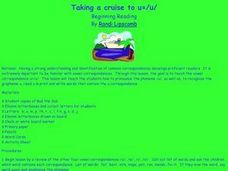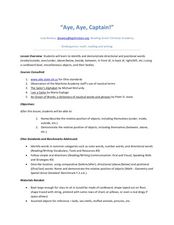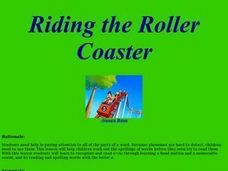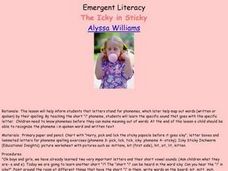Curated OER
The Creaky Door says /e/
Students explore the short /e/ sound, and identify the short /e/ in writing. Students read fun sentences from the board which emphasize the short /e/. They stretch out the /e/ sound every time they come to it while reading. They then...
Curated OER
E-E-E-E-Extra E-E-E-E-Effort
Students listen to a tongue twister emphasizing the short e sound. They practice writing the letter e and attaching different words with that sound to it. They listen to a book about a dog that enhances the letter e. They write a...
Curated OER
What's Behind the Creaky Door?
First graders are introduced to the concept that letters stand for the mouth moves that we make when sounds are made. They practice making the /e/ sound and compare it to the sound a creaky door makes and then try saying the tongue...
Curated OER
Taking a Cruise To U=/u/
Students complete a variety of activities related to the short /u/ sound. As a class they recite a tongue twister, then spell different words containing the short /u/ using letter manipulatives. Students then read the book "Bud the...
Curated OER
Home Spelling Practice: Long I, Long O
In this spelling instructional activity, learners learn to spell a list of 20 words. All contain the sound of long O or long I. Students write each word one time on the lines.
Curated OER
Sounds of Y
In this sounds of y practice learning exercise, students discover that y can be a consonant or a vowel as they respond to 6 questions.
Curated OER
What Do Seals Eat?
Learners recognize the ea=/E/ correspondence in spoken and written words. They participate in a group letterbox lesson. In groups of two, they practice reading with each other, taking turns reading one page at a time, identifying the...
Curated OER
Comparatives
In this comparatives worksheet, students review and discuss adjectives. They define adjectives as words used to compare two things using superiority, equability and inferiority. They then complete six comparative prompts by creating...
Alabama Learning Exchange
Phonics lesson for -ick family
Kindergarteners and first graders develop phonemic awareness for words that contain -ick. Each learner gets a stack of cards with different -ick words, highlighting the target sound as they review each one.
Curated OER
Icky, Icky, Sticky!
Students explore phonemes in spoken words as well as their corresponding graphemes in written words. They practice the short vowels /i/ and /e/. Students perform activities to practice sounds. They identify pictures with a particular...
Achieve3000
Discriminating Phonemes 2
Some sounds sound very similar! Help your class learn how to distinguish between various sounds by following the steps outlined in this plan. The plan includes a warm-up, a teacher-led portion, and details for guided and independent...
Houghton Mifflin Harcourt
Silly Stories: Extra Support Lessons (Theme 1)
Kids who need extra support with the concepts in the Houghton Mifflin Harcourt thematic unit on silly stories, will benefit from this packet packed with skill builders, activities, exercises, and practice sets.
Curated OER
Ellen the Elephant
Students build their sight vocabulary. They study the short vowel correspondence e. They practice pronouncing the /e/ phoneme when shown the grapheme e in written words. They read e = /e/ and write words that contain the e...
Curated OER
Fluency is Freedom!
Students read orally in groups of two to increase reading speed and fluency in this lesson. They read provided books which emphasize the short vowel sounds. The pairs time each others reading and offer encouragement and support as they...
Curated OER
Grandpa Ed
Students engage in an emergent literacy lesson that focuses on phonemic awareness. For practice they become more comfortable with a short vowel phoneme, which can often be the most difficult to identify, by learning it in isolation.
Curated OER
Aye, Aye Captain
Learners investigate how correspondences appear differently in different words. They also recognize the difference between long and short vowels. Students study how these correspondences are spelled and pronounced differently.
Curated OER
Listen Up!
Students explore the short /e/ sound. They practice writing the letter 'e' and making the short /e/ sound. They recite an 'e' tongue twister and practice finding the short /e/ sound in spoken words. They identify pictures of words...
Curated OER
Everyone is Reading
Students study /e/ in both written and spoken words using a tongue twister and letterbox activities. They recite a tongue twisters and make words using letterboxes. Next, they read "Red Gets Fed" and find words that contain the /e/...
Curated OER
Riding the Roller Coaster
First graders recognize the short vowel a in written and spoken language. Through matching and listening activities, they discriminate the vowel sound /a/ from other phonemes. Students associate the phoneme with its letter representation...
Curated OER
Open Wide at the Dentist, "Aaaahh"
Study the /o/ in both written and spoken words by reciting a tongue twister and making words using Elkonin letterboxes. Next, write a message about frogs using /o/ words. Finally, listen to a short book talk on "Doc in the Fog" before...
Curated OER
The Icky in Sticky
Students study the /i/ sound by listening to it in words and a tongue twister which they later recite. Next, they practice writing the letter and making word using letterboxes. They listen to 'Icky Sticky Inchworm' while placing their...
Curated OER
Red is My Pet!
Students complete a variety of activities related to the short /e/ sound. As a class they recite a tongue twister, and write the letter E. Students then listen to the book "Red Gets Fed," and identify the words in the story that...
Get Fluent
Get Fluent in French: Going on Holiday
Take a vacation into French with lots of vocabulary and plenty of activities. This collection of worksheets includes instruction as well as practice and invites French language learners to hone their translation skills.
Curated OER
Letter Hunt
Students search for and find certain letters, blends, or vowel combinations in words, sentences and paragraphs. They investigate how these letters, blends or combinations are used in "every day" writing.

























